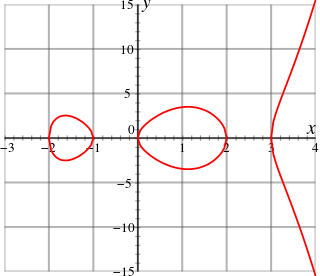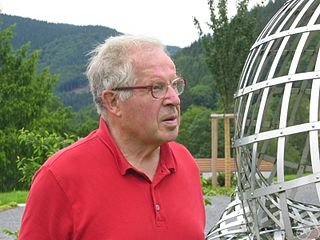Related Research Articles

Algebraic geometry is a branch of mathematics which uses abstract algebraic techniques, mainly from commutative algebra, to solve geometrical problems. Classically, it studies zeros of multivariate polynomials; the modern approach generalizes this in a few different aspects.

Jean-Pierre Serre is a French mathematician who has made contributions to algebraic topology, algebraic geometry and algebraic number theory. He was awarded the Fields Medal in 1954, the Wolf Prize in 2000 and the inaugural Abel Prize in 2003.
In mathematics, the Weil conjectures were highly influential proposals by André Weil (1949). They led to a successful multi-decade program to prove them, in which many leading researchers developed the framework of modern algebraic geometry and number theory.

Oscar Zariski was a Russian-born American mathematician and one of the most influential algebraic geometers of the 20th century.

David Bryant Mumford is an American mathematician known for his work in algebraic geometry and then for research into vision and pattern theory. He won the Fields Medal and was a MacArthur Fellow. In 2010 he was awarded the National Medal of Science. He is currently a University Professor Emeritus in the Division of Applied Mathematics at Brown University.

Michael Artin is a German-American mathematician and a professor emeritus in the Massachusetts Institute of Technology Mathematics Department, known for his contributions to algebraic geometry.

In mathematics, arithmetic geometry is roughly the application of techniques from algebraic geometry to problems in number theory. Arithmetic geometry is centered around Diophantine geometry, the study of rational points of algebraic varieties.

Sir Henry Peter Francis Swinnerton-Dyer, 16th Baronet, was an English mathematician specialising in number theory at the University of Cambridge. As a mathematician he was best known for his part in the Birch and Swinnerton-Dyer conjecture relating algebraic properties of elliptic curves to special values of L-functions, which was developed with Bryan Birch during the first half of the 1960s with the help of machine computation, and for his work on the Titan operating system.
This is a glossary of arithmetic and diophantine geometry in mathematics, areas growing out of the traditional study of Diophantine equations to encompass large parts of number theory and algebraic geometry. Much of the theory is in the form of proposed conjectures, which can be related at various levels of generality.

Claire Voisin is a French mathematician known for her work in algebraic geometry. She is a member of the French Academy of Sciences and holds the chair of algebraic geometry at the Collège de France.
In mathematics, real algebraic geometry is the sub-branch of algebraic geometry studying real algebraic sets, i.e. real-number solutions to algebraic equations with real-number coefficients, and mappings between them.
John Willard Morgan is an American mathematician known for his contributions to topology and geometry. He is a Professor Emeritus at Columbia University and a member of the Simons Center for Geometry and Physics at Stony Brook University.

Alexander A. Beilinson is the David and Mary Winton Green University professor at the University of Chicago and works on mathematics. His research has spanned representation theory, algebraic geometry and mathematical physics. In 1999, Beilinson was awarded the Ostrowski Prize with Helmut Hofer. In 2017, he was elected to the National Academy of Sciences. In 2018, he received the Wolf Prize in Mathematics and in 2020 the Shaw Prize in Mathematics.
Arithmetic dynamics is a field that amalgamates two areas of mathematics, dynamical systems and number theory. Part of the inspiration comes from complex dynamics, the study of the iteration of self-maps of the complex plane or other complex algebraic varieties. Arithmetic dynamics is the study of the number-theoretic properties of integer, rational, p-adic, or algebraic points under repeated application of a polynomial or rational function. A fundamental goal is to describe arithmetic properties in terms of underlying geometric structures.
János Kollár is a Hungarian mathematician, specializing in algebraic geometry.

Noncommutative algebraic geometry is a branch of mathematics, and more specifically a direction in noncommutative geometry, that studies the geometric properties of formal duals of non-commutative algebraic objects such as rings as well as geometric objects derived from them.
Anabelian geometry is a theory in number theory which describes the way in which the algebraic fundamental group G of a certain arithmetic variety X, or some related geometric object, can help to restore X. The first results for number fields and their absolute Galois groups were obtained by Jürgen Neukirch, Masatoshi Gündüz Ikeda, Kenkichi Iwasawa, and Kôji Uchida prior to conjectures made about hyperbolic curves over number fields by Alexander Grothendieck. As introduced in Esquisse d'un Programme the latter were about how topological homomorphisms between two arithmetic fundamental groups of two hyperbolic curves over number fields correspond to maps between the curves. These Grothendieck conjectures were partially solved by Hiroaki Nakamura and Akio Tamagawa, while complete proofs were given by Shinichi Mochizuki.

Shreeram Shankar Abhyankar was an Indian American mathematician known for his contributions to algebraic geometry. He, at the time of his death, held the Marshall Distinguished Professor of Mathematics Chair at Purdue University, and was also a professor of computer science and industrial engineering. He is known for Abhyankar's conjecture of finite group theory.
Ivan Cherednik is a Russian-American mathematician. He introduced double affine Hecke algebras, and used them to prove Macdonald's constant term conjecture in. He has also dealt with algebraic geometry, number theory and Soliton equations. His research interests include representation theory, mathematical physics, and algebraic combinatorics. He is currently the Austin M. Carr Distinguished Professor of mathematics at the University of North Carolina at Chapel Hill.

Andrew Victor Sutherland is an American mathematician and Principal Research Scientist at the Massachusetts Institute of Technology. His research focuses on computational aspects of number theory and arithmetic geometry. He is known for his contributions to several projects involving large scale computations, including the Polymath project on bounded gaps between primes, the L-functions and Modular Forms Database, the sums of three cubes project, and the computation and classification of Sato-Tate distributions.
References
- ↑ Draisma, Jan; de Jong, Johan P. (2011). "On the Casas-Alvero conjecture" (PDF). Eur. Math. Soc. Newsl. 80: 29–33. ISSN 1027-488X. Zbl 1292.12001. Archived from the original (PDF) on 2016-03-04.